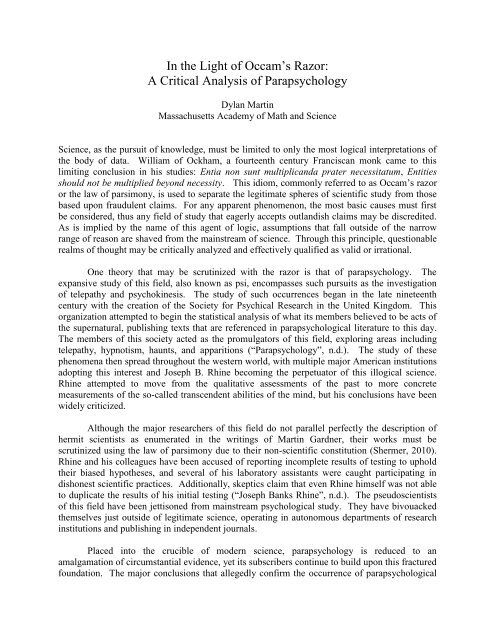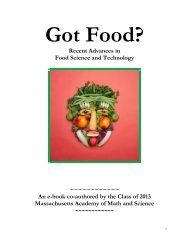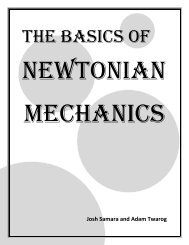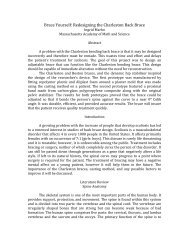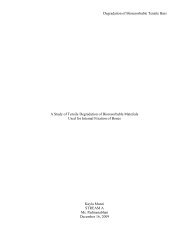In the Light of Occam's Razor: A Critical Analysis of Parapsychology
In the Light of Occam's Razor: A Critical Analysis of Parapsychology
In the Light of Occam's Razor: A Critical Analysis of Parapsychology
You also want an ePaper? Increase the reach of your titles
YUMPU automatically turns print PDFs into web optimized ePapers that Google loves.
<strong>In</strong> <strong>the</strong> <strong>Light</strong> <strong>of</strong> Occam’s <strong>Razor</strong>:<br />
A <strong>Critical</strong> <strong>Analysis</strong> <strong>of</strong> <strong>Parapsychology</strong><br />
Dylan Martin<br />
Massachusetts Academy <strong>of</strong> Math and Science<br />
Science, as <strong>the</strong> pursuit <strong>of</strong> knowledge, must be limited to only <strong>the</strong> most logical interpretations <strong>of</strong><br />
<strong>the</strong> body <strong>of</strong> data. William <strong>of</strong> Ockham, a fourteenth century Franciscan monk came to this<br />
limiting conclusion in his studies: Entia non sunt multiplicanda prater necessitatum, Entities<br />
should not be multiplied beyond necessity. This idiom, commonly referred to as Occam’s razor<br />
or <strong>the</strong> law <strong>of</strong> parsimony, is used to separate <strong>the</strong> legitimate spheres <strong>of</strong> scientific study from those<br />
based upon fraudulent claims. For any apparent phenomenon, <strong>the</strong> most basic causes must first<br />
be considered, thus any field <strong>of</strong> study that eagerly accepts outlandish claims may be discredited.<br />
As is implied by <strong>the</strong> name <strong>of</strong> this agent <strong>of</strong> logic, assumptions that fall outside <strong>of</strong> <strong>the</strong> narrow<br />
range <strong>of</strong> reason are shaved from <strong>the</strong> mainstream <strong>of</strong> science. Through this principle, questionable<br />
realms <strong>of</strong> thought may be critically analyzed and effectively qualified as valid or irrational.<br />
One <strong>the</strong>ory that may be scrutinized with <strong>the</strong> razor is that <strong>of</strong> parapsychology. The<br />
expansive study <strong>of</strong> this field, also known as psi, encompasses such pursuits as <strong>the</strong> investigation<br />
<strong>of</strong> telepathy and psychokinesis. The study <strong>of</strong> such occurrences began in <strong>the</strong> late nineteenth<br />
century with <strong>the</strong> creation <strong>of</strong> <strong>the</strong> Society for Psychical Research in <strong>the</strong> United Kingdom. This<br />
organization attempted to begin <strong>the</strong> statistical analysis <strong>of</strong> what its members believed to be acts <strong>of</strong><br />
<strong>the</strong> supernatural, publishing texts that are referenced in parapsychological literature to this day.<br />
The members <strong>of</strong> this society acted as <strong>the</strong> promulgators <strong>of</strong> this field, exploring areas including<br />
telepathy, hypnotism, haunts, and apparitions (“<strong>Parapsychology</strong>”, n.d.). The study <strong>of</strong> <strong>the</strong>se<br />
phenomena <strong>the</strong>n spread throughout <strong>the</strong> western world, with multiple major American institutions<br />
adopting this interest and Joseph B. Rhine becoming <strong>the</strong> perpetuator <strong>of</strong> this illogical science.<br />
Rhine attempted to move from <strong>the</strong> qualitative assessments <strong>of</strong> <strong>the</strong> past to more concrete<br />
measurements <strong>of</strong> <strong>the</strong> so-called transcendent abilities <strong>of</strong> <strong>the</strong> mind, but his conclusions have been<br />
widely criticized.<br />
Although <strong>the</strong> major researchers <strong>of</strong> this field do not parallel perfectly <strong>the</strong> description <strong>of</strong><br />
hermit scientists as enumerated in <strong>the</strong> writings <strong>of</strong> Martin Gardner, <strong>the</strong>ir works must be<br />
scrutinized using <strong>the</strong> law <strong>of</strong> parsimony due to <strong>the</strong>ir non-scientific constitution (Shermer, 2010).<br />
Rhine and his colleagues have been accused <strong>of</strong> reporting incomplete results <strong>of</strong> testing to uphold<br />
<strong>the</strong>ir biased hypo<strong>the</strong>ses, and several <strong>of</strong> his laboratory assistants were caught participating in<br />
dishonest scientific practices. Additionally, skeptics claim that even Rhine himself was not able<br />
to duplicate <strong>the</strong> results <strong>of</strong> his initial testing (“Joseph Banks Rhine”, n.d.). The pseudoscientists<br />
<strong>of</strong> this field have been jettisoned from mainstream psychological study. They have bivouacked<br />
<strong>the</strong>mselves just outside <strong>of</strong> legitimate science, operating in autonomous departments <strong>of</strong> research<br />
institutions and publishing in independent journals.<br />
Placed into <strong>the</strong> crucible <strong>of</strong> modern science, parapsychology is reduced to an<br />
amalgamation <strong>of</strong> circumstantial evidence, yet its subscribers continue to build upon this fractured<br />
foundation. The major conclusions that allegedly confirm <strong>the</strong> occurrence <strong>of</strong> parapsychological
activity fall to mere supposition when viewed through <strong>the</strong> lens <strong>of</strong> Occam’s razor. The largest <strong>of</strong><br />
<strong>the</strong>se assumptions was that made by J. B. Rhine in his study <strong>of</strong> extrasensory perception (ESP).<br />
To examine <strong>the</strong> existence <strong>of</strong> what he believed to be psi phenomena, Rhine conducted tests in<br />
which subjects attempted to guess <strong>the</strong> order <strong>of</strong> cards in a set on which was inscribed one <strong>of</strong> five<br />
symbols. Over 90,000 <strong>of</strong> <strong>the</strong>se tests were completed, and from <strong>the</strong> ga<strong>the</strong>red data, this<br />
investigator asserted that ESP is a real and quantifiable happening (Rhine, 1973). This<br />
conclusion was based upon a small number <strong>of</strong> test subjects who were able to guess a larger<br />
percentage <strong>of</strong> <strong>the</strong> cards correctly than statistical chance predicted. Such data does not tend to<br />
show <strong>the</strong> absolute truth <strong>of</strong> <strong>the</strong> hypo<strong>the</strong>sized occurrence, as it is not a preponderance <strong>of</strong> <strong>the</strong><br />
evidence and makes unjustifiable leaps to outlandish explanations. Adhering to <strong>the</strong> law <strong>of</strong><br />
parsimony, <strong>the</strong>re are various potential explanations for <strong>the</strong>se statistical anomalies with <strong>the</strong> first<br />
being simple chance. With such a large number <strong>of</strong> tests performed, it is likely that some data<br />
points will lie outside <strong>of</strong> <strong>the</strong> predicted average. Fur<strong>the</strong>rmore, dishonesty in experimental<br />
procedure could very likely account for <strong>the</strong>se outliers in <strong>the</strong> data. Greater than ten individuals<br />
who assisted Rhine were found to be involved in fraudulent activities, yet <strong>the</strong>ir names were never<br />
released and data ga<strong>the</strong>red with <strong>the</strong>ir involvement was used to arrive at <strong>the</strong> final, bold statement.<br />
Such simple interpretations <strong>of</strong> <strong>the</strong> data place <strong>the</strong> idea <strong>of</strong> metaphysical happenings far beyond <strong>the</strong><br />
scope <strong>of</strong> veritable science.<br />
A second tenet in <strong>the</strong> field <strong>of</strong> parapsychology is <strong>the</strong> belief in <strong>the</strong> supernatural importance<br />
<strong>of</strong> near-death experiences. By definition, a so-called near-death experience occurs when an<br />
individual comes close to death or experiences clinical death and is revived; many <strong>of</strong> those who<br />
have been in such a state report feeling elation and seeing <strong>the</strong> image <strong>of</strong> a light forming at <strong>the</strong> end<br />
<strong>of</strong> a tunnel (“Near-Death Experiences”, n.d.). Men and women <strong>of</strong> <strong>the</strong> pseudoscientific world<br />
have attributed <strong>the</strong>se feelings to a variety <strong>of</strong> phenomena including <strong>the</strong> journey to a realm <strong>of</strong> life<br />
after death and have <strong>of</strong>fered <strong>the</strong>se qualitative observations as evidence <strong>of</strong> <strong>the</strong> pr<strong>of</strong>essed afterlife.<br />
These individuals have strived to make scientific claims based solely upon <strong>the</strong> vague accounts <strong>of</strong><br />
those who underwent such trauma, and thus base what <strong>the</strong>y believe to be rational conclusions<br />
upon questionable, second-hand observations.<br />
<strong>In</strong> addition to this fundamental error in <strong>the</strong> scientific reasoning behind parapsychologists’<br />
explanation for <strong>the</strong>se visions, <strong>the</strong> religious and paranormal associations <strong>of</strong> near-death<br />
experiences are inane when viewed in <strong>the</strong> light <strong>of</strong> Occam’s razor. A plethora <strong>of</strong> simple,<br />
scientifically accepted causes for <strong>the</strong>se commonly reported sensations exist. The first <strong>of</strong> <strong>the</strong>se<br />
elucidations is that humans close to death <strong>of</strong>ten enter a state <strong>of</strong> shock, in which <strong>the</strong>y may<br />
experience delirium and impaired sensory perception, hence <strong>the</strong> sight <strong>of</strong> a small amount <strong>of</strong> light<br />
and feeling <strong>of</strong> euphoria. Ano<strong>the</strong>r logical cause <strong>of</strong> contentment and unusual visions during a<br />
near-death experience are <strong>the</strong> potential physical ailments that caused a person to enter an infirm<br />
state. Two common conditions that cause death or near-death are brain trauma and severe blood<br />
loss, both <strong>of</strong> which can cause impaired mental abilities and altered visual perspective. These<br />
explanations for <strong>the</strong> sensations <strong>of</strong> near-death experiences are significantly more parsimonious to<br />
<strong>the</strong> conventions <strong>of</strong> science, and thus must be considered before <strong>the</strong> miraculous contrivances <strong>of</strong><br />
parapsychologists.
The study <strong>of</strong> parapsychology, while intriguing, cannot stand to meet <strong>the</strong> demands <strong>of</strong><br />
Occam’s razor. When <strong>the</strong> conclusions and core beliefs <strong>of</strong> its various branches are viewed<br />
through <strong>the</strong> enlightening perspective <strong>of</strong> this law <strong>of</strong> logic, <strong>the</strong>y are found to be illogical and<br />
beyond <strong>the</strong> scope <strong>of</strong> a legitimate science. Due to grossly erroneous scientific procedure and<br />
leaps to conclusions that ignore <strong>the</strong> most basic explanations, <strong>the</strong> field <strong>of</strong> psi cannot be regarded<br />
in <strong>the</strong> body <strong>of</strong> well-founded scientific knowledge and must be removed from all empirical<br />
thought. The law <strong>of</strong> parsimony requires all who seek to pursue sensible science to regard<br />
parapsychology as a pseudoscience.<br />
Literature Cited<br />
About Near-Death Experiences. (n.d.) Retreived on December 11, 2012 from http://iands.org<br />
Joseph Banks Rhine. (n.d.) Retrieved on December 11, 2012 from http://wikipedia.org<br />
Parasychology. (n.d.) Retrieved on December 10, 2012 from http://wikipedia.org<br />
Rhine, J.B. (1973). Extra-Sensory Perception. Boston: Braden Publishing Company.<br />
Shermer, M. (2010, May 23). Hermits and Cranks: Lessons from Martin Gardner on<br />
Recognizing Pseudoscientists [electronic version]. Scientific American, Retrieved<br />
December 11, 2012 from http://scientificamerican.com


